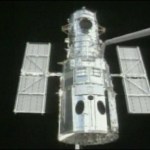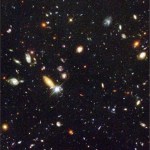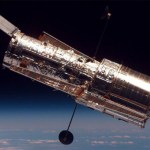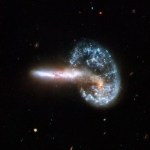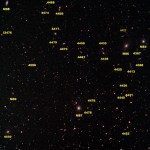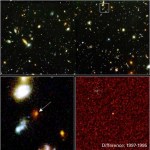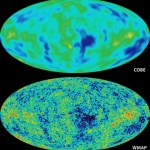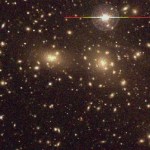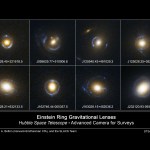Hubble
It was May, 1992, and I was in a stupor of post thesis-completion cortisol letdown and alcohol-induced lethargy, and Mark Pagel was talking to me as I slouched in a large comfortable chair in the Peabody Museum's smoking lounge.
"It's obvious what they need to do," he was saying, and I could tell from the look on his face, even in my foggy state of mind, that a morsel of wisdom marinated in humor was about to be served up.
I swear this stuff works great. "Hrmphsmeh," I replied, indicating that he should continue, I was interested.
"They need Ross Perot."
"Hrmph???," I knew Mark (and…
It is done! The longest-running and most famous camera in the world, Hubble's WFPC2, has been removed and replaced. Scientists will now get to use the Wide-Field Camera 3 (below), and WFPC2 is headed to the Smithsonian.
You've already gotten a chance to taste what WFPC2 has done for our understanding of the Universe, Planets, Galaxies, and Clusters of Galaxies in the first four parts of our series on The Camera that Changed the Universe. What else is left?
Part FiveWell, the only thing I didn't cover yet is stars. And yet, perhaps no other tool -- ever -- has been more useful for discovering…
Yesterday, the Space Shuttle Atlantis docked with the Hubble Space Telescope, and now the removal and replacement of WFPC2 has commenced.
As you probably know, I'm going to miss that camera. It's been unveiling the secrets of the Universe for the last 16 years, and in a way that no other camera ever has before. So, you can check out parts one, two, and three in my series of ways that this camera has changed the Universe, and then look below for today's edition of saying goodbye to Hubble's grand old camera, WFPC2.
Part FourOnce in awhile, we get very lucky in the Universe. Instead of looking…
Welcome to part 3 of our goodbyes to the Hubble Space Telescope's WFPC2 (the Wide Field and Planetary Camera 2, pronounced WHIFF-pic-too) instrument. For those of you who missed part one or part two, go ahead and check them out. And for those of you who don't remember, this was the camera that -- back in 1993/4 -- saved the Hubble Space Telescope. There was a "blurring" problem from 1990-1993, and that was the impetus for the service mission and the new, revamped, 610-pound WFPC2 instrument. The before-and-after results were immediate and stunning:
And so I bring you our third installment of…
Yesterday, we started our goodbyes to Hubble's outgoing camera, WFPC2. It was literally 16 years ago that they first installed this workhorse onto the space telescope:
As I write this, the space shuttle Atlantis is up there right now, on a mission to install a new, superior camera. Welcome to part 2 of the five greatest achievements that this camera has ever snapped.
Part TwoYesterday, we looked at the Hubble Deep Field, and the farthest recesses of the Universe. But this camera was great for examining objects much closer to home, too. I point you to the largest planet in our Solar System,…
As I write this, the Space Shuttle Atlantis has just blasted-off a few hours ago, headed for the Hubble Space Telescope. It's hard to believe that Hubble's been up there for more than 19 years now, and has helped revolutionize our understanding of the Universe, from measuring the Hubble constant to discovering Dark Energy. It continues to dazzle us even today.
While you can read about the servicing mission that's going on here, I'm going to focus on saying goodbye to one special instrument this week: WFPC2. (If you want to sound like an astronomer, it's pronounced WHIFF-pic-too.)
This…
One of the most surprising things about the Universe? As vast as it is, it hasn't been around forever. In fact, if you take our plain little rocky home (Earth), it looks like the Universe is only about 3 times as old as we are. It's surprising, considering how huge, expansive, and full of interesting things the Universe is.
And yet, our Sun, Earth, and entire Solar System, at 4.5 billion years, represents a significant fraction of the age of the Universe, about 13.7 billion years.
But how well do we know that number? If you look at the best data, you find that the Universe is 13.73 billion…
One of the great things about the Hubble Space Telescope is that it's been in orbit for nearly 20 years now, meaning that it's amassed a huge archive of data.
Now, one of the things that the Hubble Space Telescope is notoriously bad at is finding planets. Why? Because if you want to do it, you have to block the light from a star, otherwise you'll never see anything other than the star.
So what you can do is place something called a coronagraph over the star, which is just a little black plate that blocks the star's light, and lets you see around it. This was first used for the Sun to view…
(Thanks to Starts With A Bang! reader benhead.) The Hubble Space Telescope has released some beautiful images of colliding galaxies in a huge collection! Here are some of my favorites, with my very own names for them (real name in parentheses).
We'll start with the Glowing Arrow (Arp 148):
The Highway Windshield (NGC 6240)
The Flaming Splinter (NGC 6670):
And finally, I call this one "my new desktop wallpaper:"
I was going to write a whole bunch about this, but I have been beaten to the punch by Universe Today, Bad Astronomy, and Will Gater. I'll have to wake up earlier next time! In the…
You've all heard these words before. Dark Energy. But what is it, and why are we stuck with it? Let me start by telling you a story.
Imagine, for a minute, that you have a candle. You know everything about this candle, including how bright it is and how far away it is from you. Like so:
Now if I move this candle twice as far away, I know it's going to be one-fourth as luminous. If I move it three times as far away, I know it's going to appear one-ninth as luminous. And if I move it a thousand times farther away, I know what I see is going to be one-millionth as luminous as the original…
What's going to happen to all the stars in the Universe as they get older? Well, just as nothing can live forever, stars can't live forever also. Why? Because they run on fuel: burning hydrogen into helium, for example. When they run out of fuel, something's gotta give. Barbara Ryden reminds us of an excellent and appropriate quote by Dylan Thomas:
Do not go gentle into that good night.
Rage, rage against the dying of the light.
But what exactly happens to the star depends very sensitively on what the mass of the star is.
If you've got a tiny little star, less than about 40% of the mass of…
Aaah, the Virgo cluster. A huge cluster of hundreds of galaxies, and our closest large neighbor in the Universe. People have known for a long time that although Virgo is still redshifting away from us, it isn't quite as fast as we would expect from the Hubble expansion rate of the Universe. Does this mean that we're gravitationally bound to it, and some day, we'll move into this dee-luxe apartment in the sky?
Nope. Dark energy is here to push it away from us, and we'll unfortunately see this bright neighbor recede farther and farther from us, until it disappears from our sight. So say your…
Sure, there's dark energy, but what does that really mean? First off, there's the bizarre phenomenon we see: very distant objects appear dimmer than we expect in a Universe filled with just matter and space. This supernova (above) should appear much brighter for how distant it is, based on what we know about supernova. This means one of three things are going on:
Supernova were intrinsically different when they were younger, and inherently fainter.
Some type of dust is blocking the light from distant supernova, making them seem fainter.
These supernova are actually farther away than we had…
The cosmic microwave background is the radiation left over from the big bang. It's very uniform, 2.725 Kelvin everywhere. We're moving with respect to it, so there's a doppler shift, and we see that as a dipole moment in the Temperature. When we subtract that out, we see variations on the order of 30 microKelvins! WMAP is a satellite (Wilkinson Microwave Anisotropy Probe) that measured these anisotropies, and they just released its year 5 data. First off, with the uniform and dipole parts subtracted out, and with the foreground from the galaxy also taken out, here's the map of the microwave…
Last week, Pamela Gay over at Star Stryder pointed me to a press release which claimed that, among other things, perhaps dark matter wasn't necessary. So I wrote a guest post on her blog explaining why it was. Apparently, some people still aren't convinced. So I will lay out for you all the reasons I can think of why we need it, and explain what happens if you try to do without it.
1. Cluster Velocity Dispersions. When we take a look at galaxies, we often find hundreds or even thousands of them clustered together, like in the Coma Cluster. We can measure how quickly those galaxies are moving…
One of the perks of being a postdoc at a place like the University of Arizona, one of the top places in the US for astronomy, is that we get a number of really interesting visitors. Today we got paid a visit by Tommaso Treu, an astronomer at UC Santa Barbara.
He spoke to us today about one of his most recent, most interesting discoveries, done with the Hubble Space Telescope, of a double Einstein Ring. Take a look at the image below:
You'll notice that there's a ball of light in the center with some ring-like structure(s) around it. These things are rare, first off. There are only two ways…

